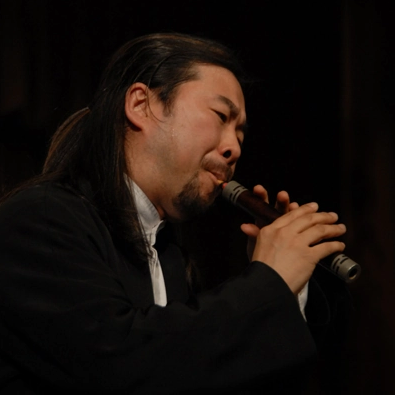Guo Xiang
Organized by 不知桃夏 on 2022-03-15
 Guo Xiang, a national first-class actor, is a pipe player of the Beijing Radio Chinese Orchestra. He is also a superb saxophone player.
Guo Xiang, a national first-class actor, is a pipe player of the Beijing Radio Chinese Orchestra. He is also a superb saxophone player.In 1964, Guo Xiang entered the middle school attached to the China Conservatory of Music and became the first group of people who learned to play the pipe with Mr. Hu Zhihou. Later, Guo Xiang successively learned to play the pipe from the old folk artists Zhao Chunfeng and Zhang Zongkong. After graduating from the High School Attached to the China Conservatory of Music, Guo Xiang joined the army and joined the Railway Army Art Troupe with a musical instrument. After the Cultural Revolution, he changed his career to the Chinese Film Orchestra Chinese Orchestra. It was with a pipe in his hand that Guo Xiang loudly opened a smooth path connecting life and art.
The bili, also known as the pipe, is one of the ancient wind instruments, mostly used in the military. Popular in northern my country. The timbre of the tube is loud, crisp, with strong personality, high volume, and strong imitation and expressiveness. This musical instrument has a wide range of uses and is mostly used in local opera, folk wind ensembles, and monastic music.
The timbre of the pipe is unique. It has been handed down from ancient times to the present, and its status in the performance of folk music in my country has been declining day by day, but it is extremely respected in Japan, South Korea and other countries. Guo Xiang said that the music in the north is majestic and simple, while the music in the south is ethereal and elegant. The oboe, bassoon and other musical instruments belong to the same kind of double-reed instruments as the guanzi, but their sounds are relatively delicate and beautiful; while the guanzi (bili) is rough and powerful, and its sound can best represent the temperament of the northern nation.
As a guanzi player, Guo Xiang is very worried and regretful about the current situation of guanzi in China. As a friend of Japanese kiji player Hideki Toi, he is very envious of kiji's development in Japan. However, the disadvantage of the pipe is that the volume is too loud and cannot be retracted freely. Guo purchased processing equipment from himself. Through about 10 years of exploration and research, he has made continuous experiments and selections from materials and mouthpieces. of new wind instruments.
As a guanzi player, Guo Xiang really wants the guanzi, a national musical instrument that is about to disappear, to be revived in China.
Similar artist
Zhang Rongyi is a suona player and composer. He has a solid foundation in performance, a unique style, and is skilled in playing a variety of musical instruments, such as pipe, ka cavity, and mold flute.
read >>
Hu Zhihou, member of the Academic Committee of the Central Conservatory of Music, director of the National Wind Music and Percussion Teaching and Research Section, and concurrently the vice president of the National Wind Music Research Association of the Chinese Musicians Association.
read >>
Yang Luan_yangluan, graduated from the Central Conservatory of Music, is a 17th undergraduate and 21st graduate student. He is an up-master in the music area of station B. He currently has 13,000 fans. His videos mainly focus on wind instruments, and play niche instruments in a different flavor.
read >>
Involving musical instruments
Guanzi (pinyin: guǎn zi) is a wind instrument. In ancient China, it was called "筚篥" or "Luguan". Its structure consists of three parts: the whistle, the intruder and the cylindrical body.
Involved portfolio
夏浩东 - 75 views
迷雾风暴 - 65 views
咖喱麦兜 - 263 views
风月呢喃 - 137 views
肖毅 - 175 views
Involved news
Organized by 南丘 on 2022-03-31
Every morning, before 8 o’clock, the sound of the pipe will sound on time in the piano room 418 of the Qinfang Building of the Central Conservatory of Music. This is Hu Zhihou, a professor of the Folk Music Department of the Central Conservatory of Music, a pipe player and an educator, who is over 70 years old.
read >>
Organized by 雨童 on 2022-03-21
Bai folk instrumental music mainly includes sanxian music, suona wind and percussion music, cave scripture music, etc. In addition, there are also ancient music and tunes played by bamboo flute, mouth spring, wood leaf and so on.
read >>
Organized by Susan on 2022-03-15
The timbre of bili is either high-pitched and crisp, or sad and mournful, with distinct texture. As a part of Hu Le, it was spread to the Central Plains via the Silk Road, and it was also loved by people.
read >>
Organized by 赵锦辛 on 2022-03-15
Guanzi, anciently known as bi li , jia guan. In ancient times, there was a kind of wind instrument called "pipe". "Book of Songs, Zhou Song, You Gu": "If you are prepared, you will play, and the flute tube will be prepared." "Erya Shile": "The big tube is called the posthumous title."
read >>
Organized by 向日葵 on 2022-03-15
In March, another national event will bloom in Zhengzhou. The 2022 China Intangible Cultural Heritage Protection Annual Conference will be held in Zhengzhou from March 21 to 24.
read >>
 渝公网安备 50010702504639号
渝公网安备 50010702504639号